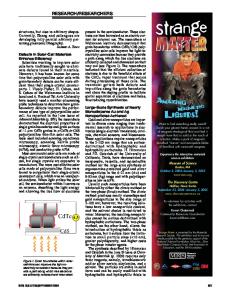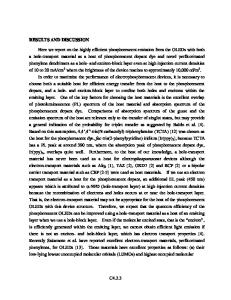Space Radiation Effects in Advanced Solar Cell Materials and Devices
- PDF / 275,527 Bytes
- 12 Pages / 612 x 792 pts (letter) Page_size
- 88 Downloads / 343 Views
Space Radiation Effects in Advanced Solar Cell Materials and Devices R. J. Walters and G. P. Summers US Naval Research Laboratory, Washington, DC 20375 S. R. Messenger SFA, Inc., Largo, MD 20000 ABSTRACT An investigation of the physical mechanisms governing the response of III-V based solar cells to particle irradiation is presented. The effect of particle irradiation on single and multijunction solar cells is studied through current vs. voltage, spectral response, and deep level transient spectroscopy measurements. The basic radiation response mechanisms are identified, and their effects on the solar cell electrical performance are described. In particular, a detailed analysis of multijunction InxGa1-xP/InyGa1-yAs/Ge devices is presented. The MJ cell response is found to be more strongly affected by the internal cell structure than by the In content. INTRODUCTION This invited talk will give a brief tutorial on the effects of the space radiation environment on the electrical properties of advanced photovoltaic materials and devices. Solar cells are the basis of nearly all spacecraft power systems. The space market for commercial communications as well as military and scientific applications is driving rapid development of new solar cell technologies to provide increased power. In particular, the approach of multijunction (MJ) solar cells, where bandgap engineering is employed in layering several semiconductor junctions in a monolithic stack, has rapidly matured, attaining record, one-sun, air-mass-zero efficiencies close to 30% [1]. However, for these advanced technologies to operate efficiently in space, they must by resistant to the harsh space radiation environment. This paper will begin with a discussion of the basic mechanisms of radiation damage in solar cell materials. The talk will then describe the physics of multijunction solar cells and show how these advanced devices respond to radiation exposure. In keeping with the general symposium theme, the presentation will focus on the InGaAs and related material systems. BASIC RADIATION DAMAGE MECHANISMS As an energetic particle passes through the atomic lattice of a material, it transfers energy to the lattice through ionizing events in which electrons in the lattice are temporarily excited to higher energy levels and nonionizing events in which collisions between the incident particle and target atoms results in displacement of atoms in the lattice. In terms of solar cell radiation-induced degradation, ionization has little effect. It is the permanent displacement damage produced by nonionizing events that degrades the device electrical performance. A calculation of the amount of energy lost to nonionizing events (i.e. the nonionizing energy loss (NIEL)) by a proton and an electron incident upon GaAs as a function of the incident particle energy is shown in Fig. 1 [2]. The calculated NIEL values show protons to be much more damaging with the amount of damage increasing as the energy decreases until the threshold for
H10.2.1
atomic displacement is reached. Fo
Data Loading...










